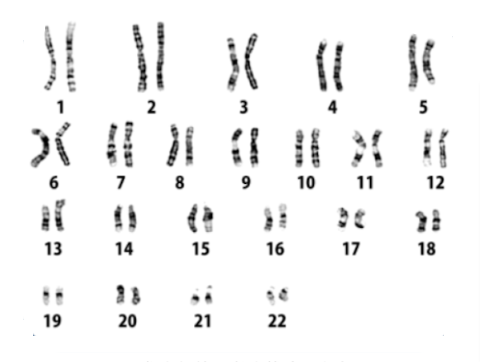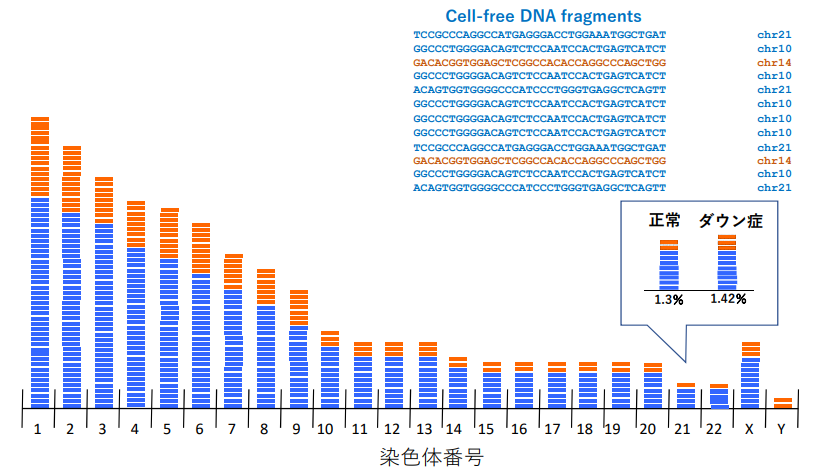NIPT
◆What is NIPT (Non-Invasive Prenatal Testing)?
NIPT (Non-Invasive Prenatal Testing) is a screening test that analyzes blood collected from the mother during pregnancy to examine chromosomal abnormalities in the fetus, such as Down syndrome (trisomy 21), Edwards syndrome (trisomy 18), Patau syndrome (trisomy 13), and others. This test, also known as Non-Invasive Prenatal Genetic Testing (NIPT), utilizes advanced technology to detect the number of all chromosomes and can identify partial deletions and duplications. It is a non-invasive screening test that can investigate not only common chromosomal disorders but also abnormalities in sex chromosomes and microdeletion syndromes. Additionally, it may determine the baby's sex through sex chromosome analysis.
NIPT is characterized by its high sensitivity and specificity compared to traditional prenatal screening tests, with the test itself being almost 100% accurate. However, it does not provide a definitive diagnosis of chromosomal abnormalities; instead, it is a screening test that determines whether there is a high (positive) or low (negative) likelihood of chromosomal disorders. Therefore, if a positive result is obtained with NIPT, further confirmatory tests such as chorionic villus sampling or amniocentesis are recommended. Additionally, there is a rare possibility of false positive or false negative results.
This test is performed by analyzing fragments of placental DNA present in the mother's blood. Since the placenta is genetically identical to the fetus, genetic information about the fetus can be obtained by examining this DNA (although amniocentesis may be necessary for confirmation in cases of mosaicism). Advances in modern high-speed genetic analysis technology have made it easier to analyze these DNA fragments. NIPT analyzes fragments of placental-derived cell-free DNA (cfDNA) that flow into the mother's bloodstream to examine for chromosomal abnormalities.
The presence of placental-derived DNA fragments floating in the blood of pregnant women enables the early acquisition of information about the fetal health status and specific genetic conditions, making it an important option for many pregnant women.

◆Principle of NIPT (Non-Invasive Prenatal Testing)
The principle of NIPT (Non-Invasive Prenatal Testing) involves using fragments of fetal-derived DNA present in the mother's bloodstream during pregnancy to examine the presence of chromosomal abnormalities. In this test, the DNA analyzed is not from the mother but from the fetus. Specifically, cell-free DNA (cfDNA) derived from the placenta that flows into the bloodstream is collected and meticulously analyzed using a machine called a sequencer. This cfDNA is used to detect the possibility of chromosomal disorders.
A sequencer is a device that reads DNA base sequences, with Next-Generation Sequencing (NGS) being used in the latest technology. With this technique, it accurately reads the four base sequences of DNA: A (adenine), T (thymine), G (guanine), and C (cytosine). Bases generally exist in pairs (A pairs with T, G pairs with C), forming the double helix structure of DNA. The sequencer reads the extracted DNA base sequences one by one and identifies genetic abnormalities.
Conventional sequencers could only read one DNA sequence at a time, requiring time and effort. However, with NGS technology, it is possible to create DNA libraries and read millions to billions of base sequences at once. This technology enables efficient detection of chromosomal abnormalities even from minimal DNA samples, such as fetal-derived cfDNA.
Massively parallel sequencing (MPS) is the standard analytical method for NIPT, based on NGS. This method quantitatively analyzes the DNA components derived from each chromosome using the obtained fetal-derived cfDNA. For example, if the fetus has trisomy 21, the result would show a 1.5-fold increase in the amount of DNA derived from chromosome 21.

Ministry of Health, Labour and Welfare NIPT: noninvasive prenatal testing 無侵襲的出生前遺伝学的検査 Citation
◆Comparison with Conventional Prenatal Testing
Compared to conventional prenatal testing methods, NIPT is characterized by its high sensitivity, specificity, and excellent accuracy. However, the positive predictive value for trisomy 18 and trisomy 13 tends to be lower than for trisomy 21. Additionally, there is a risk of false positives (when the test result is positive but there is no actual chromosomal abnormality). Therefore, if a positive reaction is obtained with NIPT, further confirmatory tests such as chorionic villus sampling or amniocentesis are recommended.
◆Detection of Microscopic Chromosomal Abnormalities
Microdeletion syndromes are disorders caused by the loss of specific genes at certain positions on chromosomes. These syndromes result from very small changes in chromosomes, with the changes existing in at least 500,000 base pairs, typically resulting from deletions of 2 to 3 million base pairs. Depending on the location and size of these deletions, the types and severity of symptoms vary, but in many cases, they may cause symptoms such as intellectual disability or developmental delays.
Many microdeletion syndromes occur spontaneously and are not significantly related to maternal age. This means that they occur not only due to genetic factors but also due to environmental factors and incidental chromosomal changes. Therefore, it is inappropriate to restrict testing to specific age groups of pregnant women, as microdeletion syndromes can occur in pregnant women of all ages from young to old.
Detection of microscopic chromosomal abnormalities, particularly microdeletion syndromes, may be difficult in general diagnostic facilities, but our testing facility can detect these abnormalities using advanced genetic testing technology. Therefore, accurate diagnosis and management of microdeletion syndromes require testing at medical institutions with specialized knowledge. Such tests play an important role in identifying potential risks early and providing necessary medical interventions and support.
◆Advantages and Disadvantages of NIPT
Advantages
- No risk to the fetus
Since the test is performed only through blood collection, there is no direct risk to the fetus. - Early testing is possible
NIPT allows for early testing compared to traditional methods. - High test accuracy
Due to its high sensitivity and specificity, it provides more accurate test results.
Disadvantages
- Risk of false positives
As it is a screening test, there is a possibility of false positives.



